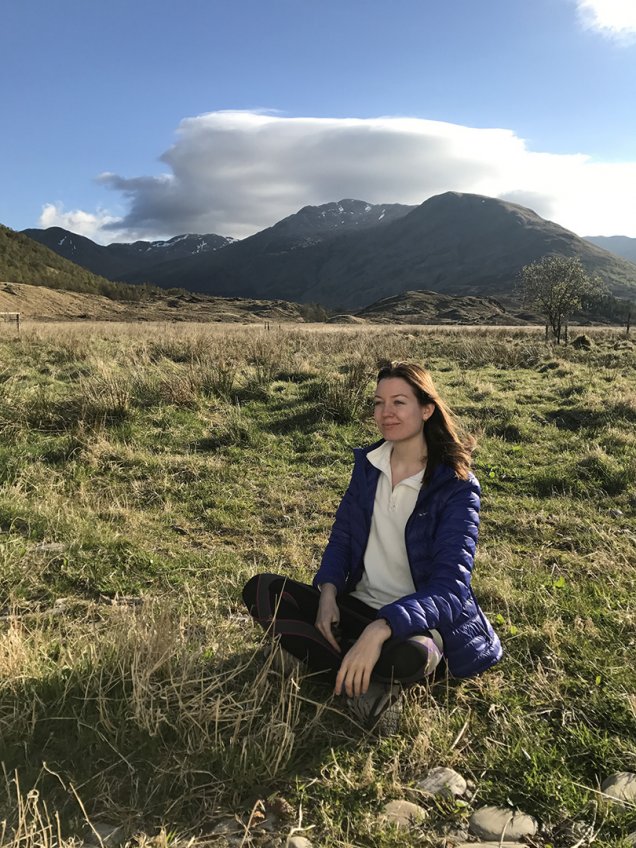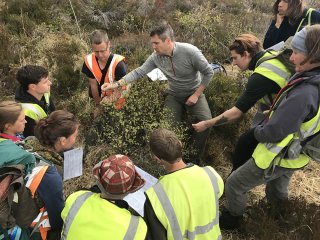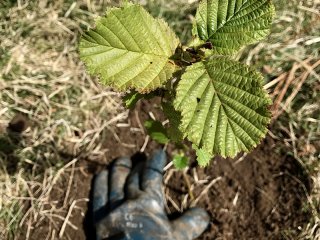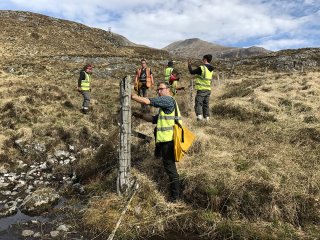Getting Dirty With Trees For Life

6:30 am. The world is white and the air is full of water. It’s that crisp morning chill when you’d rather nurse a cup of hot tea inside, or, better even, snuggle under a thick blanket. But… Cuck-oo.
You make a quick dash for the toilet room, fast enough to preserve some warmth accumulated over the night. You throw a glance at the stunning mountains veiled with fog, and the dark shapes of the trees standing alone in the open field. Cuck-oo. Cuck-oo. Cuck-oo, you’re cold to the bone when you’re done. Cuck-oo, the only sound you hear for miles around.
The kettle’s already boiling on the gas stove, and you smell the wood of the bothy and the mountain mist in your hair. Time to wake up, make breakfast and get ready for another tree-planting hike in Glen Affric, Cannich.

The bags and shovels are waiting outside, and you head out with your gang of 12. All sleepy, yet ready to work. This is why we came here. Build a new fence – posts, nails, wires; dig holes – shovel staggering over thick roots; move baby trees to their new housing. The world is primal and beautiful all around you. And quiet, so perfectly quiet. No people, except for us; no cars, airplanes, engines. Just the wind rustling in the grass.
One tree, two tree, alder tree, aspen tree. Hazel tree, willow tree, old tree, new tree. Trees go well with Dr. Seuss’ rhymes. They smell of wet soil and fresh shrubbery. Pick one up, set it in the hole, move back the pieces of earth you dug out. Press the earth down, carefully. Do a tug test, holding the sprout right above the roots to see if a deer could snatch it out. An herd of deer wanders in the distance. They’d eat everything if you let them.

One of the main challenges for volunteers is to protect the new growth from being eaten and thread upon. That’s why we’re building fences, secluding enclosures here and there. Some of them are to protect the sprouts that grew naturally from neighboring trees, which have been planted some years ago. Some to protect the new seedlings that we planted.
Planting trees is addictive. Not digging holes, mind you, but playing God and giving life to a new forest. There was a forest once where we work today, a thick and rich bundle of green. Then people turned up, and all predators were hunted down, and the industrial revolution began. And then the trees were gone, and unrestrained populations of deer destroyed what new growth turned up. Trees For Life program is the new generation looking back and trying to restore what’s been lost.
Work was varied: one day we’d dig and plant, another we’d focus on building fences. One day we had a training session in how to evaluate deer damage to new trees and bushes. One day we had free – it was Wednesday. A day to rest and relax. That’s why I went on a 9-hour hike covering three peaks over 1.000 meters tall and threading 18 kilometers until I had to get down from the mountain, down the only available path – a narrow, steep, dry waterfall bed full of rocks and deer droppings. Still not sure how I made it back to our Bothy. I remember hanging on the strand of heather until I could put my foot down on another rock. It was interesting. Don’t be like me.
I brought back a huge deer antler as a trophy. Quite obviously, the following day I could barely stand, and each move resonated in my muscles with throbbing pain. I wasn’t of much use on Thursday, but the antler proudly sat on top of the oven in the dining room until our departure, when it got cleaned and wrapped up and taken home by one caring son.

On our last day in the glen we were bringing down a fence. An exhausting endeavor, let me tell you; but seeing clear land where an old rusted fence once stood was extremely rewarding. We thought of planting a bit afterwards, but our group leaders (those nice people making sure all went according to plan, trees got planted and instruments returned to the bothy) decided to call it a day. I heard of it with my knees in the dirt, inside of the new enclosure, as I was planting my second tree. They had to pluck me out and bring me home to rest. I was very mad. Then it turned out that I was more hungry than mad, and after that was fixed, I sat with others by the cracking fire we built outside and looked back on our week.
What I could see was a little under a hundred little trees reaching for the sun because of me, covering the once bare grassland. I planted where my feet took me, where the land looked good and the soil felt firm enough. 23 trees on my first day, I recall, so few yet such hard work. I remember the hills and fields where we planted. But most of all I will remember my last two trees, the first ones to spring on a barren hillside, the last to be put in the soil by my hands. They’ll stand there tall and strong, I hope, for years to come. They’d be proof that I was there once, a good kind of proof. They’ll keep the memories and the sounds of our voices. And I’ll come back one day to see the new forest – and maybe tear down the old, rusty fence that the grown-up trees would need no more.
P.S. I sincerely thank the team of Trees For Life for this wonderful opportunity, and all my fellow tree-planters for the beautiful and warm community they created. I hope that this program will grow and thrive, and I’m looking forward to my return.
Kira Tverskaya

